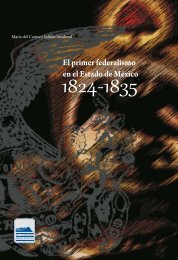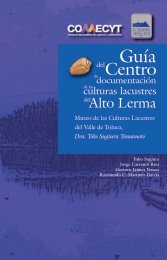You also want an ePaper? Increase the reach of your titles
YUMPU automatically turns print PDFs into web optimized ePapers that Google loves.
MARGARET CHOWNING, A BIOGRAPHY OF A CONVENT AND A PROSOPOGRAPHY OF ITS NUNS<br />
stitution that contradicted the way the Rule of<br />
their order was practiced in every other convent<br />
of that Rule. 9<br />
Adding to the dysfunction built into the convent’s<br />
constitution and worsened by the small<br />
size and divisions within the group of founding<br />
nuns was the fact that the physical plant of the<br />
nuns’ “temporary” living quarters when they arrived<br />
in San Miguel was not meant to serve as a<br />
convent, and must have been a stressful place in<br />
which to be enclosed. For the first nine years the<br />
nuns lived in a former poorhouse (hospicio) that<br />
had been hurriedly accommodated to house the<br />
nuns. This accommodation consisted largely of<br />
closing off doors and windows to the outside. A<br />
new door was cut through from the poorhouse<br />
to the church of San Rafael, and a makeshift<br />
choir was constructed in the church so that the<br />
nuns could enter the church without being seen.<br />
There was no outdoor space, since the hospicio<br />
was in the very center of the small city, with<br />
buildings all around. Because of the psychological<br />
demands of enclosure, convents generally<br />
made it a point to provide expansive patios and<br />
ample space outside the cloister for gardens and<br />
orchards for the nuns’ recreation and meditation.<br />
<strong>10</strong> The Hospicio, lacking outdoor space and<br />
dark from the boarding up of the windows, must<br />
have felt cramped and impermanent.<br />
When the nuns moved into their newly<br />
constructed convent in 1765, they had plenty<br />
of space, with an orchard and gardens large<br />
enough for the nuns to ride horses for exercise.<br />
Here the problem was different: both the church<br />
and the convent buildings were unfinished, and<br />
so they remained for decades (AGN, 1801: vol. 6,<br />
exp. 1). The walls surrounding the orchard and<br />
the rooftops were low and too easy for “gente<br />
atrevida” to surmount, threatening their chastity.<br />
Low walls also made it hard to keep cloister,<br />
since it was too easy for the nuns to see and be<br />
seen by the outside world. The wall behind the<br />
9 Nuestra Señora de la Salud of Pátzcuaro had six founding<br />
nuns from the nearby convent of Santa Catarina in Valladolid;<br />
the Capuchin convent at Salvatierra that was founded in 1798<br />
had seven founding nuns; La Enseñanza of Irapuato in 1804<br />
also had seven; and the Carmelites of Valladolid had five in<br />
1824. (AHAMICH, 1789: caja 257 (XVIII), exp. 3); (AHAMICH,<br />
1800: caja <strong>21</strong>0 (XVIII), exp. 30); (AHAMICH, 1804: caja 4 (XIX),<br />
exp. 1); (AHAMICH, 1824: caja 395 (XIX), exp. 1.)<br />
<strong>10</strong> A lengthy description of the accommodations made to the<br />
Hospicio so that the nuns could live there temporarily is in the<br />
report of Conde de Casa de Loxa, 31 Jan. 1756, (AHAMICH,<br />
1756: caja 208 (XVIII), exp. 12)<br />
altar was made of adobe and on the verge of<br />
collapse. The dormitory was notoriously drafty,<br />
with five doors and two open windows. Its walls<br />
(and the walls of the refectory) were constantly<br />
dripping water that came from the wash basins<br />
and water pipes on the roof. And there was no<br />
infirmary, despite the fact that the nuns were always<br />
sick from the cold air and humidity that the<br />
building let in (AHAMich, 1791: Caja 255 (XVIII),<br />
exp. 42; AHAMich, 1791: caja 255 (XVIII), exp. 32;<br />
AHAMich, 1806: caja 374 (XIX), exp. 1). If their<br />
temporary quarters had been claustrophobic,<br />
the new convent brought illness, fear, and a<br />
sense of danger to their bodies and souls.<br />
It was not until the 1830s and 1840s that the<br />
convent finally began to put its physical plant<br />
in order. The deteriorated garden and orchard,<br />
with its flowers and fruit trees, was cleaned, new<br />
trees were planted, and a gardener was hired<br />
(AHAMich, 1842: caja 375, exp. 39). The church<br />
was painted and repaired, and the three patios<br />
of the convent and their cloisters were whitewashed<br />
and painted. A fountain was added to<br />
each of the four corners of the principal patio<br />
on the second floor. The kitchen got new ovens<br />
and braziers, and full length glass windows<br />
were installed in the the upstairs dormitory, the<br />
workroom, and the room where they stored and<br />
manufactured medicines. Parts of the cloister<br />
were re-roofed (AHAMich, 1836: caja 375 (XIX),<br />
exp. 33). The church acquired a new bell and, in<br />
1841, work began on the bell tower of the church<br />
(AHAMich, 1841: caja 375 (XIX), exp. 38). These<br />
improvements to the nuns’ living and spiritual<br />
spaces were accompanied by additional spending<br />
on clothing and food, and by a tolerance for<br />
entertainments and servants. All this was antithetical<br />
to the spirit of the original constitution,<br />
but by this time the church’s project of reforming<br />
conventual practices and more generally popular<br />
piety, so important in the Bourbon era, had<br />
been overtaken by other ecclesiastical priorities.<br />
Biographers seek a life story that is out of<br />
the ordinary, but at the same time not so extraordinary<br />
that it cannot tell us something more<br />
generally about the world of which the subject<br />
of the biography was a part. The more I read<br />
broadly in the literature on convents, the more<br />
I was convinced that La Purísima was a good<br />
choice by these standards. The convent’s “life”<br />
began with specific disadvantages, as we have<br />
70



![bicentenario_1[V2]](https://img.yumpu.com/68677971/1/167x260/bicentenario-1v2.jpg?quality=85)
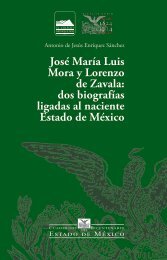
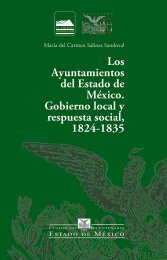

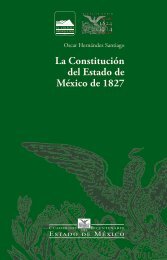
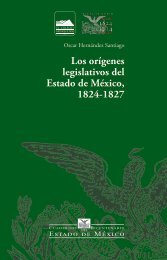

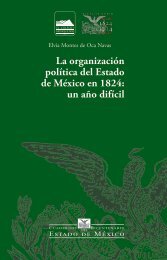
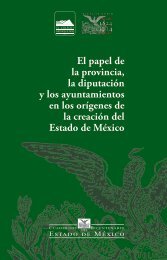
![El_primer_federalismoEM[final]_compressed (2)](https://img.yumpu.com/68483279/1/178x260/el-primer-federalismoemfinal-compressed-2.jpg?quality=85)
